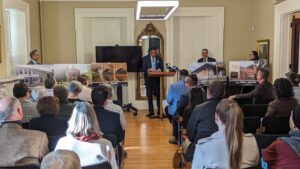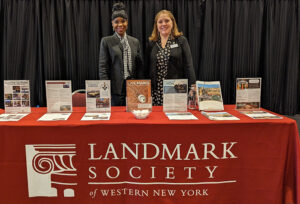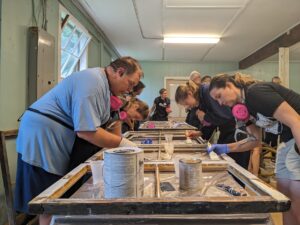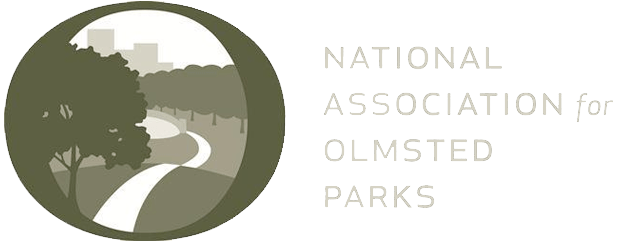
The Road Ahead: Preservation’s Role in a aTime of Change and Challenge
- May 12, 2009
- 1:39 pm
- May 12, 2009
- 1:39 pm
The following is the keynote address from our 2009 Preservation Conference in Medina, written and delivered by Roberta Lane, Program Officer and Regional Attorney for the National Trust for Historic Preservation. We were so grateful to have Roberta agree to come out from Boston to be our keynote speaker, and thank her for her insightful and timely remarks about the outlook for preservation in today’s economy.
 I want to thank the Landmark Society of Western New York for inviting me to be here to speak with you today. The preservation movement is challenged in large parts of the country for lack of preservation expertise and local capacity. It is a treat, therefore, to work in this part of New York, so well served by the Landmark Society, one of our most venerable but also most innovative and effective local partners. The Landmark Society, the Preservation League of New York State, and the state’s truly great SHPO all have deep commitments to providing preservation technical assistance. We also welcome the new presence of Preservation Buffalo Niagara, further west, and the Western Erie Canal Main Street Program, ensuring that people working in this part of the state have access to one of the nation’s strongest networks of preservation guidance and assistance.
I want to thank the Landmark Society of Western New York for inviting me to be here to speak with you today. The preservation movement is challenged in large parts of the country for lack of preservation expertise and local capacity. It is a treat, therefore, to work in this part of New York, so well served by the Landmark Society, one of our most venerable but also most innovative and effective local partners. The Landmark Society, the Preservation League of New York State, and the state’s truly great SHPO all have deep commitments to providing preservation technical assistance. We also welcome the new presence of Preservation Buffalo Niagara, further west, and the Western Erie Canal Main Street Program, ensuring that people working in this part of the state have access to one of the nation’s strongest networks of preservation guidance and assistance.
Wherever you find yourself in the country these days, though, you can’t escape the fact that we’re living in interesting times. No one has avoided the changes and economic upheaval of the last year and a half.
It has been painful to watch the economic condition of our country decline so quickly and so far. This collapse has been a sharp reminder of our profound interdependence, as nearly all parts of the country (and most of the globe) have been hit.
At this point, nearly all of us know someone who has lost a job, or who is suddenly “upside down” on their home. As more of us feel the effects of the downturn closer to home, it is only right that we’re hearing less and less about this downturn being our “grand comeuppance” and “just desserts” for enjoying more prosperous times.
Preservationists, though, do spend a lot of our time monitoring patterns of development. Over the last twenty years, we watched as sprawl laid waste to our open space and drained towns. We saw teardowns make older neighborhoods into funhouse reflections, distorted by McMansions. Big boxes and chain stores metastasized and the quality of our places – our quality of life – was under threat due to all this lax planning and overheated development.
We thought we were seeing danger signs and mania in the overvalued property markets for awhile. I think we could be forgiven for feeling a little moralistic when the tide turned, and the systemic, ill effects of overconsumption and weak controls became dreadfully apparent.
Our interdependence makes it tougher and more pointless to say “we told you so” now. Much as being self-satisfied and righteous are my favorite ways to be – and they are – preservationists have a different role now. Our role is urgently important: we are part of the solution.
I work for the National Trust for Historic Preservation, helping people protect, enhance, and enjoy the places that matter to them. We provide leadership, education, advocacy, and resources to build the nation’s preservation movement and to revitalize communities. We do this through our headquarters in DC, our nine regional and field offices, 29 historic sites, and networks of relationships – our 270,000 members, our partner organizations, and our National Trust Main Street Center.
The National Trust is in a unique position to observe preservation efforts and conditions in older and historic communities across the country. We are in overdrive at the moment, tracking and responding to our new economic and political reality. It can be a struggle even to concisely define what the latest changes mean for preservation, and we use a lot of language like “mixed blessing,” “bittersweet,” and “silver lining” to give a sense of the mixed bag of challenge and opportunity we face.
This is particularly stark in the case of the federal economic stimulus package, which has the potential to cause both unprecedented threats and to generate real needed funding for preservation. We’ve just started to call that ultimate paradox the “Perfect Storm.”
I’ll touch quickly on some of the challenges we’re anticipating as a result of the recent economic shifts. I think most are painfully obvious.
First and foremost, of course, every part of the preservation movement is dealing with reduced funding from nearly all sources. You name it:
· preservation developers are struggling to get financing for new projects, or to sell or lease finished projects;
· preservation agencies, SHPOs, city planning agencies are all dealing with budget cutbacks;
· grantmakers and individual donors have much less to give, in most cases, and so preservation and community nonprofits are facing tough times;
· historic sites have lower visitation and reduced budgets for things like maintenance and promotion.
Is there a silver lining there? Maybe not, but it is worth noting that the preservation movement has never been flush. We’re used to shoestrings and lots of creativity, and we’ll weather this too.
Another challenge: in the funding context or in the policy context, there is the risk for leaders and the public to see preservation, now more than ever, as a frill or an unaffordable luxury. It’s very important that we not concede on that, though we may contend with folks who are really determined to dismiss us on this basis. For reasons I’ll explain, preservation is more relevant today than before. The more we illustrate our role in solving a community’s difficulties, the better we can combat this misperception that preservation was an indulgence for better days.
Organizations large and small, here in New York, are making this case successfully. In Port Jervis, I recently visited with the leader of the Minisink Valley Historical Society. They recently completed a great roof repair and repointing project on Fort Decker, the Historical Society’s home, posting all about it on their blog. You might be interested to see it, as they illustrated the whole project from fundraising through the work itself, to completion. They raised nearly all of the funding locally, and very creatively, getting an earmark from the local representative, raising money from local businesses, and tapping their donor base. It took a village to put that roof on, but they managed it, even in tough times. They made the case that their cause was still relevant and that the popular programming and services provided at the Historical Society made the community a better place. And they allowed people to follow their progress and to feel like a part of the action.
Another example is Preservation Buffalo Niagara, formed recently from the merger of two organizations, in order to create a more full-service, unified voice for preservation in Buffalo and the surrounding region. In eight months or so, they have raised hundreds of thousands of dollars from foundations and other funders, because they have so effectively demonstrated the need for and potential of preservation in that area. In Buffalo, they have tapped into a great pride of place and the pervasive understanding that the city’s great architecture and neighborhoods are the key to overcoming its forbidding, distorted image.
The final challenge I’ll mention is that desperation for economic development can lead communities to make choices that are self-defeating. Sadly, this “we’ll take anything” approach – chain drugstores on every corner, mass demolition for ill-conceived civic centers, etc. – reigned in lots of places even when the money was flowing. It was tough to deal with then, and may be even more prevalent now.
How then, is preservation part of the solution and the recovery?
And how can we head off the most destructive responses to the crisis in our communities?
Preservationists always talk about how the greatest chance to move places toward a more sensitive development approach and better planning is after a great loss. Now, in most places, in a variety of ways, we just suffered through a period of destruction and inappropriate development.
People are waking up now very worried about the implications of all that. The reaction against those old approaches has been extreme. People’s shopping patterns are changing (and not just for lack of money). They are genuinely excited about buying locally. Malls are no longer the default mode, and in fact, many are dying. People are embracing density and realizing that long commutes will not be sustainable, so more are returning to downtowns and cities. If these shifts are properly enabled, this refocus on our historic centers will secure their future as vital, quality places.
The need for increased efficiency is also driving communities toward more regional planning – always a good thing. You can work now with your regional planning agencies to support broader approaches to transportation and development, reducing sprawl and inefficient policies.
I mentioned federal stimulus funding before. That federal investment is an opportunity, and many local governments are just trying to figure out whether there are local projects that they could advance for funding. Preservationists across the country are stepping up to help localities determine which preservation projects could be funded through stimulus, with great results. The National Trust is tracking these efforts, and all the details of the federal stimulus that affect preservation, on our website, www.preservationnation.org. Visit the site to learn more about accessing stimulus for preservation.
There is also a real sense of urgency about sustainability and conservation of our resources. The National Trust’s Sustainability Initiative has undertaken research, outreach, and programming to give depth and resonance to our call that the greenest building is an existing building. We have worked with the US Green Building Council to review its standards for LEED certification so that they more fully reflect the energy savings of using older and historic buildings. We are also working with Congress on the current Energy Bill to give extra tax credits for weatherization when the house or building is on the National Register.
This same truth extends to the protection of older and historic communities. These tend to be centrally located, dense, walkable, and are often mass-transit accessible – qualities celebrated and promoted by Smart Growth advocates. Reinvestment in existing communities also utilizes the energy embodied in existing roads and water, sewer and electric infrastructure.
At the same time, it is a great time for preservationists to buy property or property interests to save places, if you’re able. While most preservationists have steered clear of raising funds to buy property for awhile now, there are ways to use real estate acquisition for preservation that don’t involve holding and having to maintain the place in perpetuity. Our land trust colleagues do this as a matter of course, using easements, partial interests, and related tools to protect places they identify as significant. Even in this down economy, these kinds of bold, place-saving efforts can be successful. Land trusts, most of which are all-volunteer, managed to raise more money for these real estate deals last year through bond campaigns than ever before. People were willing to vote to raise their own taxes, all over the country, to save important places.
It is also a good time to do state-of-the-art land use planning, as development pressure is reduced. Now is the time to restart efforts to institute historic districts and other preservation regulations. It is also prime time to investigate and employ tools to update outdated zoning, to address the teardown phenomenon that took hold in many older residential neighborhoods, and to reverse local policies that promote sprawl.
There is also a new emphasis on transparency and political accountability nationwide. In some towns, the greatest threat to community character and the built environment has been shortsighted political leadership and entrenched interests. The time is ripe to work with others in your community to address these problems at their root. Some towns have had great success in cultivating and electing candidates that embrace preservation-based planning and revitalization. Get your candidates lined up!
The first order of business, though, is to take up the reins of public discourse without delay. Frame the issues of development, planning, leadership, and sustainability in your communities. It has never been cheaper or easier to do that than it is now. You can get the word out on blogs, letters to the editor, your own website, Facebook, or YouTube. The Syracuse preservation organization, Preservation Association of Central New York, uses a listserv, with volunteers posting every day on planning and preservation issues at the local, state, and national level. This listserv reaches a list of hundreds of local and regional leaders – City Council, County leaders, Planning Board members – as well as our usual preservation audience – driving the conversation in that city in the most effective and cost-effective manner imaginable. The National Trust’s own website, Preservation Nation, was the site of “This Place Matters,” last Preservation Month, and this month again, because it was so successful. Hundreds of people around the country were moved to print out “This Place Matters” signs, snap a photo in front of their favorite place, and post it on our site. This fun, public campaign helps reinforce the fundamental point that preservation makes our lives better. Use technology and the media to shape perceptions and raise awareness of preservation, and to illustrate the direct relevance of our movement.
Finally, cite and illustrate that preservation is economic development.
Get to know your Industrial Development Administration and your town’s economic development department. Promote the great examples of preservation as an economic driver.
Historic districts, for example, have been proven to stabilize property values, time and again. Decades of work at the National Main Street Center have demonstrated how economically valuable our distinctive historic business districts are. They are human-scaled, they promote social interaction and a sense of place and community. These business districts flourish when they are properly nurtured at the local level, creating jobs, feeding the tax base, and paying great dividends throughout local economies.
The historic places and the unique neighborhoods you are working to save are assets. Places that have retained their character draw new residents and they draw tourists. Boat tours are picking up on the Erie Canal, as tourists seek a unique historic and cultural experience.
Preservation and rehabilitation projects are more labor-intensive than new construction, so that these projects create more jobs – a point that has never been more vital. Make sure that your leaders and local developers know the power and profit of preservation.
You can point to examples of these economic effects close to home. East Aurora is a success story and destination today because of the visionaries who saved and then restored the Roycroft Campus. Cooperstown, too, thrives due to its status as unique heritage experience. Preservationists in Saratoga Springs have fought to preserve its historic character, upon which so much of the town’s economy relies today.
To intensify this economic activity, join us in advocating for expansion of the state’s historic rehabilitation tax credit program, led by the Preservation League of New York State. Later today, you will see the Newell Shirt Factory here in Medina, which was rehabilitated by developer Andrew Meier, with Clinton Brown Architects, and with tax credit syndication help from the National Trust Community Investment Corporation. These projects are transforming communities for the better, and New York’s credit needs to be expanded so that your towns can benefit.
Preservation acknowledges the importance of history. Preservation also makes economic sense. Preservation is the route to livability in our communities. It recycles the best of what we already have. Most importantly, it is the only approach that can promise ALL of these things. The future of preservation, then, is in understanding it’s breadth, and bringing its benefits to communities in a proactive and meaningful way. There has never been a more vital time to do this than now, to help our communities heal and prosper.
Thank you.
SHARE




